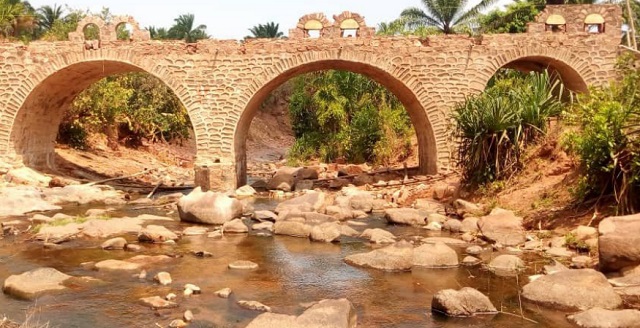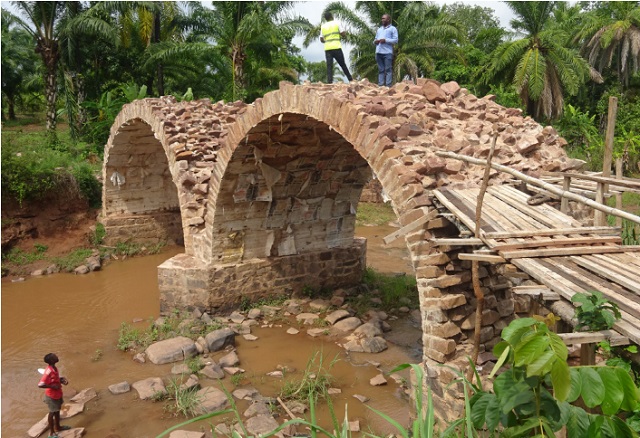
They are five times cheaper than equivalent concrete ones
| SOTIRIS KANARIS | It is common for residents of the Kigoma region in north west Tanzania to make dangerous crossings of rivers to reach workplaces, schools, hospitals and markets during the rainy season. But for many, such journeys will soon no longer be necessary as a result of a new bridge construction programme. Removing the inherent risks involved in crossing rivers could also bring global benefits.
Safe year-round river crossings are being delivered with the construction of 70 stone arch bridges, as part of Belgian development agency Enabel’s Sustainable Agriculture Kigoma Region Project (SAKiRP). For this project, co-funded by the Belgian and Tanzanian governments, Enabel is working with Tanzanian rural and urban road agency Tarura, the regional branch of the ministry of agriculture and local communities.
The aim of the project, launched in 2016, is to upgrade agriculture value chains but it has also resulted in a new approach to bridge construction.
“One of the interventions in the value chain is to improve the access to markets for smallholder farmers and that’s where the bridges come in,” says Enabel junior expert rural infrastructure Willem van der Voort.
In a country where reinforced concrete bridges are the most common form of river crossing, a decision to construct stone arch ones is unconventional.
Enabel opted for this bridge type because of experience gained in Congo and Uganda in its previous incarnation as the Belgian Technical Cooperation. Projects in those countries showed that stone arch bridges are cost efficient, allowing for more to be built with available budgets.
Tanzania’s stone arch bridge construction programme started in early 2018 and already 44 have been completed. There has been no shortage of expertise among local engineers and craftsmen, thanks to a detailed construction manual compiled by Enabel.
The manual provides supervisors with an easy step by step guide to planning and construction processes. The stepwise approach aims to ensure adherence to quality requirements and construction methodology.
It includes detailed design tables for semicircular and segmental arch bridges. The tables provide exact figures for parameters such as thickness of keystone, arch radius, thickness and abutment height as well as minimum foundation depths depending on the bridge span selected.
“Stone arch bridges were the mainstream technology (around the world) until the 1920s or so (…) These design tables are rooted in empirical evidence and, so far, we have very good experience with them,” says Enabel’s SAKiRP project manager Steven Hollevoet, whose knowledge in the field was instrumental in the creation of the manual. The longest bridge built for the project to date is 31 meters.
“The spans of single arches range from 1.5m to 8m for Roman – semi-circular – arches and from 3m to 10m for segmental arches,” van der Voort explains. The capacity of each bridge is 40 tonnes, which is several times more than the requirements for rural roads in the country.
An advantage of standardising the design of the bridges is that relatively little engineering input is required for each bridge. Senior lecturer at Brunel University London and project consultant Dr Adrienn Tomor adds that standardisation saves time and costs.
Tomor was impressed with the detail of the design tables and when she checked them using relevant software she identified overdesign. She also found differences in the way these stone arch bridges are being constructed compared to their European equivalents.
Van der Voort explains: “We work with rough stone and relatively inexperienced masons, compared with those who built European bridges in the 17th to 19th centuries. To cope with the risk of imperfections in craftsmanship, our bridges are overdesigned.”

Cost-efficiency
Building stone arch bridges is very labour intensive and construction costs can be prohibitively expensive as a result.
But the bridges built for this project are five times cheaper than equivalent concrete ones, says Pharles Ngeleja who is Tarura regional coordinator for the stone arch bridges in Kigoma region. Lower costs were achieved through the engagement of local communities and because of lower materials costs.
Unlike government infrastructure projects, there are no contractors involved. Enabel provides surveying, design and supervision resources, while Tarura brings supervision and asset management of built structures. It also mobilises local communities.
The communities that will benefit from a bridge provide volunteers to excavate foundation pits, gather sand and collect stones and pieces of wood. They also help with masonry work and raise money to contribute to the payment of labourers.
Materials costs are minimised because a significant amount of the materials used are sourced in the area near the site. Enabel tops up some of these materials if required – sometimes it has to bring better quality sand from other parts of the country. It also provides cement.
Construction costs are further limited by reusing arch formwork which requires large amounts of timber, an expensive material in Tanzania. “You can reuse it between five and 10 times before it degrades too much. We have different sets of formwork for the spans that we most often have to build,” van der Voort says.
These solutions bring the cost of materials below those for reinforced concrete bridges of the same size, according to the project team. There are further cost savings because no heavy machinery is needed, according to Hollevoet.
The long lifespan of stone arch bridges makes comparative costs even lower. Van der Voort says that the stone arch bridges should last at least 100 years at a conservative estimate, claiming that they have a longer lifespan than concrete bridges built in the country.
“The concrete bridges that are built here are often of lower quality than in Europe because of the way the concrete is poured, the quality of the aggregates, the mixing and so on. So their lifespan here is not very long.” Hollevoet adds that stone arch bridges are not prone to the corrosion which affects the steel reinforcement in concrete bridges.
Construction process
Once a site is selected and the preliminary survey – which includes an assessment of hydrology, soil type and river bank condition – is carried out, those involved in the construction process are trained.
Work often has to stop during the rainy season because of flooding so foundations are prepared during the dry season. In the meantime, a head mason trains craftsmen to construct the arch on timber formwork.
Construction of the arches and the proper placement of the stones is the most challenging part of the process, Hollevoet says.
“In terms of management (the most challenging part) is quality control, making sure that the masons and labourers adhere to the minimum principles of good construction. And that means that all gaps are filled, there is a good bond, stones are washed, etcetera,” he adds.
The time needed to construct each bridge varies according to the span, weather conditions and time of year. During busy periods for the agriculture sector, there are fewer volunteers.
Even though constructing a stone arch bridge is more labour intensive than building a concrete one of the same size, Hollevoet says the stone arches take similar or even less time to build. He explains that concrete used in concrete bridges takes a month or longer to cure, while a week is enough for that used in stone bridges.
Global revival?
The SAKiRP bridge programme ends in June 2023 and construction of the 70th and final bridge started last December. Van der Voort says Enabel will soon make a decision about whether it will construct more bridges as part of the work to improve agriculture supply chains.
More stone arch bridges may be constructed in the Kigoma region of Tanzania, even without Enabel’s involvement. Ngeleja says Tarura’s senior management team was impressed with the low construction costs and it is looking into using this technology in other parts of the country.
Hollevoet believes the project demonstrates that stone arch bridges are an ideal solution for developing countries with limited budgets looking to develop their road networks at district and village level.
For more economically developed countries, he says that even though the cost advantage of stone bridges may be affected by higher labour costs, increased demand for these structures could originate from the drive to cut carbon emissions.
He explains that the carbon footprint of stone arch bridges is significantly lower than that of reinforced concrete bridges because less cement is used.
Tomor believes that materials costs for stone arch bridges can be similar to concrete bridges in developed countries if random rubble is used instead of cut stone, because the former is often disposed of by quarries and therefore can be bought at a relatively low price. “The other option is to use recycled stones,” she adds.
Tomor has been a strong advocate for the construction of such bridges in the UK. She initiated a project to build one in Bristol, which in 2016 was granted the first planning permission for a stone arch bridge in the UK for more than 100 years. Ultimately the project did not proceed, but Tomor is now working on an application to build a stone arch bridge in Devon.
She highlights the fact that there is no British standard for the design of stone structures, such as buildings and bridges. She is working on introducing stone design into the curriculum for civil engineering.
“But for that you also need to create guidelines. It will take some time…that’s why in the meantime is so important to provide standard designs,” Tomor adds.
She is also planning to adopt what has been done in Tanzania and develop an international design guide.
Tomor concludes: “This will enable people internationally, just to take the standard tables and build stone bridges. The capacity and material needs obviously will have to align with each country’s standards.”
****
Source: New Civil Engineer’s news
 The Independent Uganda: You get the Truth we Pay the Price
The Independent Uganda: You get the Truth we Pay the Price





